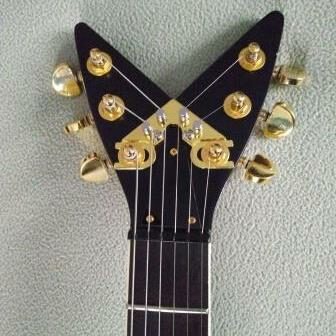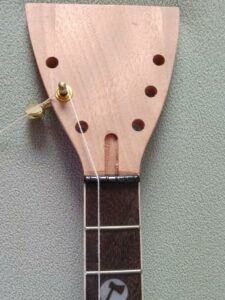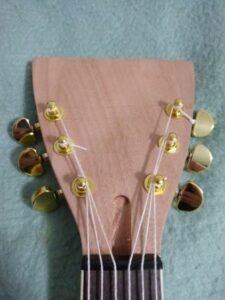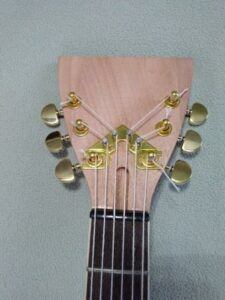A butler is a high-ranking domestic service worker in charge of keeping things in order. You may have seen the term “butler” used to describe a number of items, such as a closet butler, tie butler, or belt butler used to keep those things in order. And for a guitar headstock, there is the String Butler to clean it up and make it more efficient.
More specifically, the String Butler is primarily for the Les Paul style headstock. The Les Paul headstock is iconic but presents unique challenges due to its design. The strings must angle towards the tuning machines after passing over the nut, which can affect both playability and tuning stability.
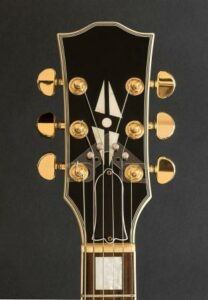
String alignment, in essence, is pivotal. When strings are angled, they may bind in the nut slots, causing tuning problems and affecting your playing experience. I emphasize the need for a straight pull across the nut to maintain consistent tension and tuning – something traditional Les Paul designs don’t always provide.
That’s where technology comes in to bridge the design with functionality. A device like the String Butler can transform the tuning experience for guitars with this type of headstock. It is precisely crafted to address the inherent string alignment issues of the Les Paul headstock by ensuring that strings are guided straight.
Just imagine every string ringing true, staying in tune through the wildest bends and vigorous strumming sessions. The simple addition of a String Butler can turn that scenario into reality. The next part of this article will delve into the mechanics of this clever device, explaining why it might be the missing piece in achieving your optimum guitar performance.
Design and Functionality
If you have a guitar with a 3×3 headstock, you might have noticed that tuning can sometimes be a frustrating experience. This is where the String Butler comes into play. Let’s dissect its design and functionality to understand how it improves your guitar’s tuning stability.
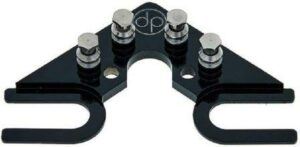
The String Butler is a simple, yet ingenious device that fits under the first and sixth string tuning machine retainer nuts on your guitar. Its purpose is to guide the second, third, fourth, and fifth strings so that they pass straight over the nut, rather than at an angle. This is particularly useful for guitars like the Les Paul, where the headstock design naturally causes the strings to splay outward after they cross the nut.
Installation of the String Butler is straightforward. Once fitted, each string sits between a pair of carefully engineered rollers. These rollers, akin to those on a roller bridge, mitigate friction and the common wear and tear on strings as they are tuned and played. Such a reduction in friction means you can expect a smoother tuning process, less string breakage, and overall enhanced tonal consistency.

The straight path facilitated by the String Butler allows for more uniform tension across the strings, which is a fundamental aspect of maintaining tuning stability. By addressing the inherent string angle problem of certain headstock designs, guitar players will notice a remarkable reduction in the common tuning woes that have long been accepted as part of the Les Paul experience.
String Butler Usage and Compatibility
If you play a guitar with a 3×3 headstock configuration like a Gibson Les Paul, you understand the value of keeping those strings in perfect harmony. The String Butler is tailored for this specific design, enhancing the instrument’s overall tuning stability. But it’s crucial to note: this device has its limitations and isn’t the right fit for every guitar out there.
First, it’s indispensable to determine the compatibility of your guitar with the String Butler. This gadget is specifically designed to suit 3×3 headstocks, where the three tuning machines on each side of the headstock can benefit from its functionality. If your guitar has a different headstock arrangement, such as 6 inline tuners typically found on Fender-style headstocks or a 4 x 2 configuration seen on some electric guitars, the String Butler won’t be a suitable application.
While the concept might seem appealing for all types of guitars, there’s a reason it’s limited to those with 3×3 headstocks. The physics of string tension and alignment on a guitar require tailored solutions, and the String Butler addresses the unique angle issues presented by specific Les Paul models. Its design isn’t universally applicable, but when it’s a match, the benefits are clear.
How do you choose the correct String Butler for your guitar? It’s pretty straightforward. Look at the color and finish of your hardware – with options like chrome, black, gold, and transparent, you can match or contrast the aesthetic of your beloved instrument. Bring out a caliper to measure your tuning pegs if needed, ensuring the device you choose fits snugly under the first and sixth tuning machine nuts.
A Unique Application for the String Butler
You may be wondering why we would be talking about the String Butler on a DIY guitar building website. Sometimes DIY electric guitar kits, especially moderately priced middle to lower end kits, don’t always have the pre-drilled tuning machine holes located properly, or they may be oversized making it hard to position the tuners so that all strings have the proper clearance. The String Butler can help to alleviate some of those problems.
Recently I received a “New Design” kit from Pango. And to be fair, they don’t even offer this style kit for sale any more. Perhaps the biggest reason for that is a headstock design that simply will not work. Yes, you could build it, but it would look hideous and you would never be able to keep it in tune.
Consider this picture of the headstock design as it came from Pango. In the first picture, you can see how the fifth (A) string comes directly across the sixth (E) string tuner after it exits the nut at a ridiculous angle. In the second picture, I have mocked up the headstock layout with kite string. It is obvious that all of the strings will interfere with each other. Maybe they were trying to imitate a Dimebag Darrell type headstock but failed. Clearly no thought was given to how this might be assembled and it was never tested.
However, I am not one to give up. I was determined to make this into a playable instrument. As you are building your DIY electric guitar kit, you probably will not have to deal with one quite this awful. But you will encounter issues. Make it your goal to understand what needs to be done to correct design, manufacturing, or even builder errors. I believe you can make almost any DIY electric guitar kit into a great, playable instrument. It just takes thought and effort.
Fixing A Flawed and Thoughtless Design
After I pointed out the problems and with a little coaxing, Pango did offer to make a new neck with the traditional headstock layout. But I have found dealing with this company very difficult. Instead, I brought the String Butler concept to the rescue.
Fortunately the spacing of the first and sixth tuning machines was within the standard range. It was the other four that were the problem. So, I put this string guide in place and then pulled the kite strings across the nut again. Now there was no interference between the individual strings, and as a bonus they came straight across the nut as the butler was intended to be used. I marked the location of the top and then cut the headstock to make a “V” shape with the vertex at that spot. It ultimately came out looking pretty good.

This faulty headstock design could have made my kit a complete unplayable disaster, but the String Butler has resolved that issue.
Choosing the Right String Butler
The String Butler comes in black, gold, silver (chrome) or clear (transparent). It is also available in different sizes to accommodate varied spacing between the first and sixth tuning machines. There is even a model that replaces the truss rod cover and does not require fitting between the tuners. The String Butler is available at Amazon through the String Butler Store where they can guide you through selecting the proper one for your application.
There are also other unbranded models that are similar to the String Butler, though you should check them carefully as quality may be compromised. They can be half the price, maybe less, and might be a suitable alternative if only to see if the design is something that might work for your kit.
I’ve saved my poorly designed kit from the trash can. But it may also be that your well-designed kit, or your Les Paul style finished electric guitar, will benefit from a String Butler string guide. It certainly improves the tuning stability and, at least on a LP style headstock, looks pretty cool.
Have you used a String Butler or something similar? Leave a comment below and let us know how it helped you.
